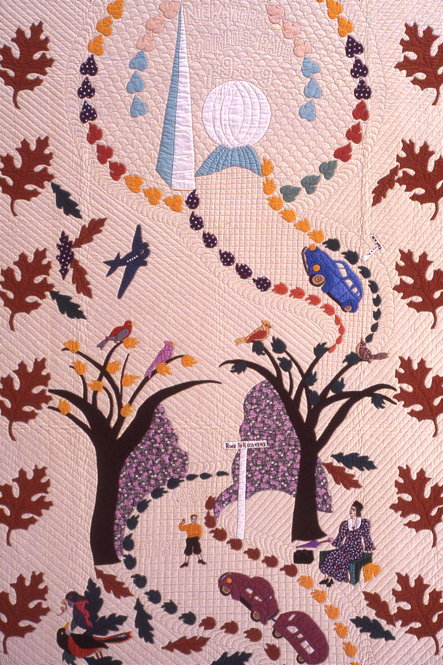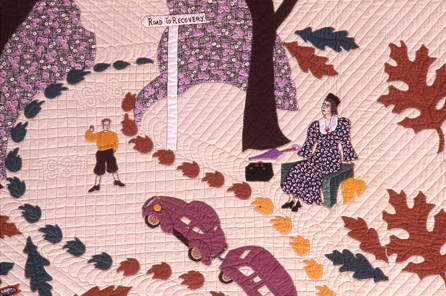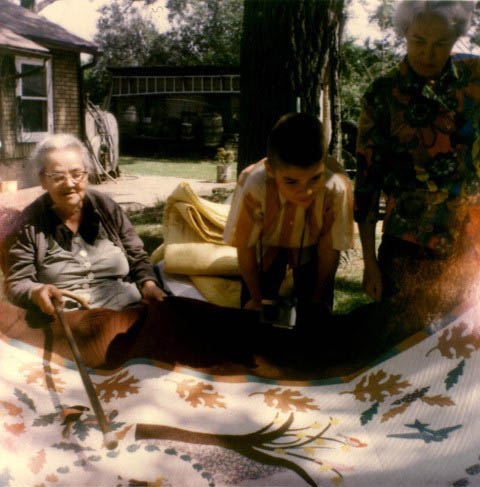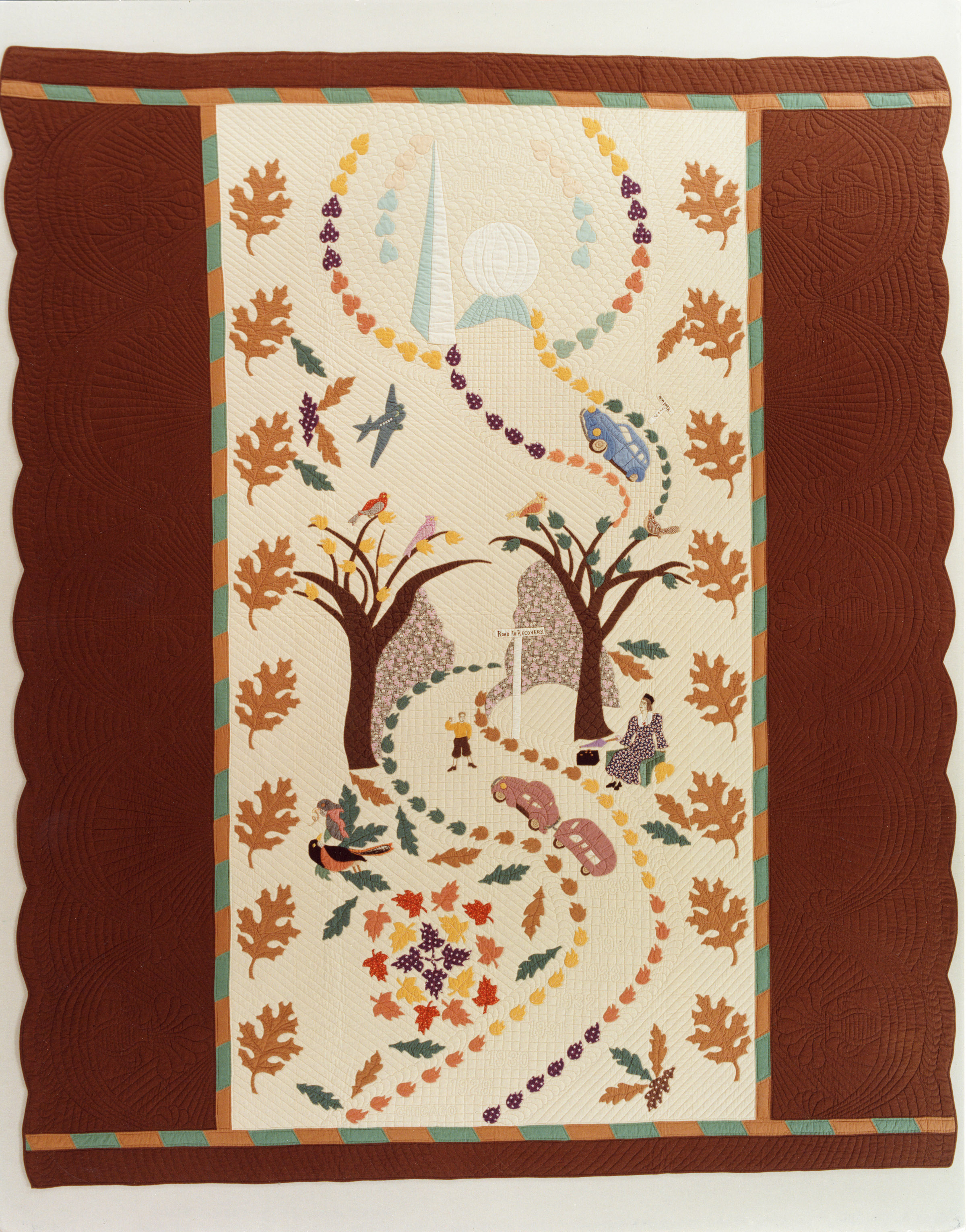
QUILT INDEX RECORD
18-14-98
Description:
Mary Gasperik's original design to commemorate the 1939 New York World's Fair was made for a quilt contest Better Living in the World of Tomorrow. She did not win a prize, but it is considered one of her masterpiece quilts. Although she did not sign this quilt, she often said the seated woman appliquéd in the center of the quilt represents herself. The pattern source for two of the appliqué elements in this quilt, the pair of robins in the lower left and the brown wren at the right side of the tree on the right, have been identified. Gasperik traced them from illustrations by Fern Bisel Peat published in popular books about birds printed in the early 1930s. In copying the robins from a book, Gasperik not only traced the book illustration's outlines to create her appliqué pattern, but she also duplicated Peat's detail through elaborate embroidery.
Essay:
Through her quilt, Gasperik interpreted the 1930s era as a journey along a roadway from depression to hope and then recovery. The journey's end is depicted by the Trylon and Perisphere, symbols of the 1939 New York World's Fair. Mary Gasperik wrote her thoughts about her original design in Hungarian, "This dear old lady is trying to bear the trials of poverty inflected upon her by the depression, and in passing along with the years, she must stop and rest to gather fresh courage to reach the 'World of Tomorrow.' Heedless of the traffic, only one thought persists in her mind, to attain her goal. The autumn leaves represent the poverty of the depression as it touched humanity. The birds are singing songs of encouragement. Beyond those mountains lies Recovery, the New York World's Fair of 1939." (Translated by daughter Elsie Krueger).
The Trylon and Perisphere, which appear on this and other New York World's Fair quilt contest entries, were the emblems of this fair in much the same way that Star Arcturus (#048) represented the 1933 Chicago Fair. Mary's decision to represent the Fair's theme Better Living in the World of Tomorrow as an automobile road may have been influenced by the importance of the automotive exhibits at the Fair and her devotion to the Quilt Club Corner sponsored by The Detroit News. The Ford Motor Co. exhibit, which occupied the highest site at the Fair, was called The Road to Tomorrow, an elevated highway more than half a mile long [The Detroit News, April 9, 1939, p 13 of the Rotogravure Section].
The 1939 contest, sponsored by Good Housekeeping Magazine and Macy's Department Store in New York City, attracted only 250 entries—far fewer than the 24,000+ the 1933 Sears Contest (Chicago World's Fair) did. It may have been the fact that the contest asked for original designs only to depict the New York World's Theme—Better Living In The World of Tomorrow or it may have been the fact that the nation was turning its eyes to a war in Europe.
The winning quilts/quiltmakers were: 1st Place Power by Elsie G. Heller (Allegheny, PA) ; 2nd Place Olive Branch by Mrs. Roy Barsalou (Dubuque, IA) ; and 3rd Place: Universal Progress by Mrs. W. E. De Neff (Spokane, WA). [Anne Orr, "The Winners of Our Quilt Contest" Good Housekeeping (Aug 1939), 61.]
Gasperik consulted a Paragon kit #01005 called Noah's Ark to fashion the winding road layout which is the guiding design of this quilt. It should be noted that Gasperik used a similar winding road to design her Indians (#056, #028, #039, #019, #022, #077, #076)children's quilts (of which she made 7). It should also be noted that Paragon kit #01005 included patterns for 2 ponies and some elephants. Gasperik added ponies of this same size and shape to the quilts the family calls Farmer in the Dell (#029 and ##059). Those two quilts were made from a different Paragon kit (#01013) which did not include a horse/pony pattern unit. It also appears possible to Salser that the elephant in Noah's Ark could have provided the outline for 5 elephants Gasperik quilted into Indians quilt #056. Although Gasperik never made an actual Noah's Ark quilt, she evidently made good use of that Paragon kit.
Susan Salser has identified the probable pattern source for one of applique elements in this quilt, the pair of robins in the lower left. They were copied from illustrations by Fern Bisel Peat published in popular books about birds printed in the early 1930s.
Where are the records for this quilt housed?
Mary Gasperik Legacy Project
Who documented this quilt?
Mary Gasperik Private Collection
Gasperik Legacy Project Number:
066
This is a:
Finished quilt
Quilt's title:
Road to Recovery
Owner's name for quilt:
Road to Recovery
Names for quilt's pattern in common use:
New York World's Fair Quilt
How wide is the quilt?
78 inches
How long is the quilt?
95 inches
Shape of edge:
Other
Describe the edge:
Scalloped right and left sides; straight edges at top and bottom.
Shape of corners:
Other
Describe the corners:
Scalloped right and left sides; straight edges at top and bottom.
What color is the quilt?
Beige or Tan; Brown; Cream; Green
Overall color scheme:
Bright or primary colors
Type of inscription:
Message
What is inscribed on the quilt?
Quilted inscriptions bottom to top read: CHICAGO, 1929, 1930, 1931, 1932, 1933, 1934, 1935, 1936, 1937, 1938, culminating at the top with NEW YORK WORLD'S FAIR 1939.
Road signs pointing the way read: "Road to Recovery" and "New York City."
Method used to make the inscription:
Embroidery; In the quilting
Location of inscription:
multiple locations
Time period:
1930-1949
When was the quilt started?
1939 (contest was announced in Good Housekeeping, January 1939, on page 61).
When was the quilt finished?
1939
Family/owner's date for quilt:
1939 (quilts had to be submitted by May 1, 1939)
Date estimated by an antique dealer, quilt historian or appraiser:
1939
Who estimated the quilt's date?
Merikay Waldvogel
Further information concerning dates:
1939 World's Fair Contest entry.
Describe the quilt's layout:
Vertical bands
Subject of the quilt:
1939 New York World's Fair
Number of borders:
2
Describe the borders:
Two wide borders of solid brown are placed at right and left of the central vertical pictorial panel. Two narrower borders of solid brown are placed at top and bottom of the center panel. Two very narrow borders, pieced of alternating stripes of tan and green, frame the center panel and extend to the sides.
Fiber types used to make the quilt top:
Cotton
Fabric styles used in the quilt top:
Print; Solid/plain
Applique techniques used to make the quilt top:
Hand Applique
Embellishment techniques used to make the quilt top:
Embroidery
Can you feel or see paper on the quilt that was used as a construction aid?
no
Materials used to make the back:
Cotton
What color is the back of the quilt?
Beige or Tan
Describe the back:
Solid/plain
Materials used in the quilt binding:
Cotton
How is the binding made?
Bias grain
What is the width of the binding (measure on the top only)?
less than a half inch
What kind of filling is used in the quilt?
Cotton
How are the layers held together?
Hand quilting
Thread type used for the quilting:
cotton
Color of thread used in the quilting:
off white
Can you see any knots on the front or back of the quilt?
no
Quilting designs used, overall motifs:
Clamshell; Elbow/fan; Grid square; Single parallel lines; Other
Quilting designs used, decorative motifs:
Other
Quilting designs used, background fills:
Grid/crosshatch; Parallel lines; Other
Describe the quilting designs used:
Swags, fan-shaped radiating lines, and feather-filled vases used in in side borders. Years and world's fair name also quilted in.
Features or notes about the quilt's appearance, materials, or construction:
Gasperik used the two vertical plain brown borders as a canvas on which to display some of her most elaborate and unique quiltING designs. Unlike many of her quilts, this one is NOT filled with designs from Colonial Quilts and Needleart Guild. It is deliberately intended to be a modern quilt, rather than a quilt reflecting what popular magazines of the thirties presented as traditional American quilt design.
Quilt top made by:
Gasperik, Mary
Quilted by:
Gasperik, Mary
Where the quilt was made, city:
Chicago
Where the quilt was made, county:
Cook County
Where the quilt was made, state:
Illinois (IL)
Where the quilt was made, country:
United States
How was this quilt acquired?
Inheritance
Tell the story of how the quilt was obtained:
Selected by daughter Elsie during a division of quilts after Gasperik died in 1969. This quilt was selected by Karen in the first round when she and her sisters Linda and Susan divided up the quilts left by their mother Elsie after she died in 1988.
Describe anything about the history of the quilt that wasn't already recorded in a previous field:
Elsie Gasperik kept and maintained the quilts her mother left behind in the East Hazelcrest house after Mary Gasperik died, in May 1969. In about 1980 she and her siblings divided up 19 quilts. This quilt was among that group and Elsie selected it. Gasperik tended to keep those quilts which she and others regarded as her finest efforts. There is some indication that she asked her daughter to approach a museum about accepting them. It was after the ensuing rejection by The Art Institute of Chicago that Elsie decided the quilts should be divided among her siblings.
Why was the quilt made?
Challenge or Contest entry; Commemorative
The quilt was made to be used for:
Artwork/wall hanging
Quilt is presently used as:
Keepsake/memento
Describe present uses of the quilt:
Mary's grandchildren regard her quilts as a unique collection to be preserved and appreciated.
Where did the maker get their materials?
Purchased new
Where did the maker find their pattern?
Original to maker
Describe the source of the pattern:
Mary's source of the winding path may have come from Paragon Crib quilt No. 01005 Noah's Ark Design. She used a similar element in other quilts.
Where did the quiltmaker find the pattern for the quilting design on the quilt?
Original to maker
Describe where the quilting design pattern was found:
Bird illustrations by Fern Bisel Peat, Saalfield Pub. Co., Akron. Ohio, copyright 1931
Describe anything about the design of the quilt that wasn't already recorded in a previous field:
The theme of the 1939 New York Fair was transportation, perhaps explaining Gasperik's decision to depict a road with a traveling car. Two of the emblems of this Fair are appliqued at the top of the quilt: the needlelike Trylon and the Perisphere globe.
There is indication that there was a 2nd Gasperik New York World's Fair quilt project. It disappeared from Gasperik's house during her final illness. Elsie's typed notes describe it as "New York World's Fair unfinished top geometric starburst on tan background" under a category she called "Quilts and tops which are still in East Hazelcrest". She listed 5 items in this category. The other four are: Laurel Wreath (with birds), tulip squares unfinished top, nursery rime [sic] unfinished top, and Rainbow fan quilt unfinished top. It is not known what became of these. Most significantly, it is not known if the mentioned "Laurel Wreath with birds", which is not described as unfinished, is the surviving Laurel Wreath quilt (#067) or if there was a second completed Gasperik Laurel Wreath quilt.
Exhibitions where this quilt was displayed:
At least one Tuley Park quilt show, year unknown: a exhibit slip reading "New York Worlds Fair Quilt Made by Mrs. M. Gasparik" [sic] survives.
The Quilts of Mary Gasperik, Ravenswood Historic Site, Livermore, CA, March 14-15, 1992.
8th Annual Quilters' Heritage Celebration, Patchwork Pride, Barbara Brackman curator, Lancaster, PA, April 6-9, 1995.
American Remembers: Quilting the Twentieth Century. The Ronald Reagan Presidential Library & Museum, Simi Valley, CA April 3-October 4, 1998.
This is one of the 23 Mary Gasperik quilts exhibited in the Carnegie Room of the Marion Indiana Public Library July 16-17, 2021 in connection with the ceremony honoring the induction of Mary Gasperik into The Quilters Hall of Fame as their 2021 Legacy Quilter honoree. Mary Gasperik Quilters Hall of Fame Induction Exhibit.
A New Deal for Quilts, The International Quilt Museum, Janneken Smucker, curator, Lincoln, NE, October 6, 2023 - April 20, 2024.
Contests entered:
Better Living In The World of Tomorrow 1939 contest sponsored by Good Housekeeping in conjunction with Macy's Dept Store in New York and the New York World's Fair.
Publications (including web sites) where this quilt or maker was featured:
Barbara Brackman "Virgie Stewart and the Tuley Park Quilting Club" in Quilters' Journal #31 (1987), 14-16. Note: Virgie Stewart is incorrectly identified as the maker of Mary Gasperik's Road to Recovery.
Merikay Waldvogel and Barbara Brackman. Patchwork Souvenirs of the 1933 Chicago World's Fair, (Nashville, TN: Rutledge Hill Press, 1993)102-103.
Merikay Waldvogel "One American Dream Comes True", Quilters Newsletter Magazine, March 2008, 46-49. The article includes a color photograph of 'Road to Recovery' properly credited to Mary Gasperik.
Related items such as diaries, obituaries, wills, household inventories, or pictures of the quiltmaker:
Owner Karen Krueger Finn has a small swatch of red print fabric her grandmother used to cut out the maple leaves. In fact this swatch bears the cut-out shape.
Color photo (dated June 1968) of Mary Gasperik, daughter Elsie Krueger and great-grandson Andy Finn with this quilt. Gasperik is pointing to herself depicted as the woman sitting beside the Road to Recovery.
Program for The 8th Annual Quilters' Heritage Celebration, Patchwork Pride, April 6-9, 1995 Lancaster Host Resort and Conference Center, Lancaster, Pennsylvania (Karen Krueger Finn, private collection).
Color photograph of this quilt featured in “One American Dream Comes True” by Merikay Waldvogel, Quilters Newsletter, March 2008, p.49.
The Bird Book: Observations of Bird Life, by Frank North Shankland. Illustrated by Fern Bisel Peat, 1931, The Saalfield Publishing Company, Akron, Ohio. Book #672. Illustration called "The Robin".
Bird Neighbors, No. 2129, copyright 1936, The Saalfield Pub. Co., Akron, Ohio. Illustrations by Fern Bisel Peat, "The Robin" and "The House Wren".
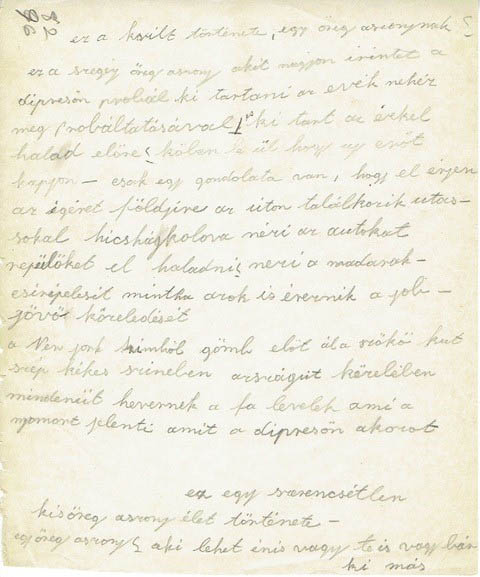
Gasperik's handwritten written explanation, in Hungarian, of 'Road to Recovery' (Karen Krueger Finn, private collection).
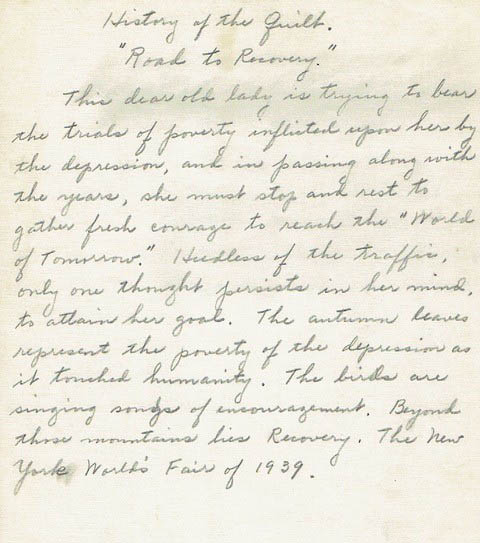
Handwritten ( there's a typed version too) translation from Hungarian to English by Elsie Krueger of Gasperik's written explanation. Entitled History of the Quilt 'Road to Recovery' Karen Krueger Finn, private collection).
Ownership of this quilt is:
Private
Quilt owner's name:
Karen Krueger Finn
Quilt owner's country:
United States
Person filling out this form is:
Relative of quiltmaker; Author/researcher
Source of the information on this quilt:
Sister of quilt owner
If you are a relative of the quiltmaker, how are you related? The quiltmaker is my:
Grandmother
Describe the relationship to the quilt's maker:
Grand-daughter Susan Salser began this research effort in 1991, after she and her two sisters divided up the quilts which belonged to their mother (Elsie Gasperik Krueger) who died in 1988. Her ongoing research has been fruitful and interesting.
Quiltmaker's maiden name:
Mihalovits, Maria
Quiltmaker's gender:
Female
Quiltmaker's birth date:
01/25/1888
Quiltmaker's birthplace, country:
Hungary
Quiltmaker's marriage date(s):
11/18/1906
Quiltmaker's date of death:
05/25/1969
Quiltmaker's ethnic background/tribal affiliation:
Hungarian
Quiltmaker's educational background:
Elementary School
In which kind of environment did the quiltmaker live?
Rural
Quiltmaker's city:
Chicago
Quiltmaker's county:
Cook
Quiltmaker's state:
Illinois (IL)
Quiltmaker's country:
United States
Quiltmaker's father's name:
Mihalovits, Istvan
Quiltmaker's father's birthplace:
Hungary
Quiltmaker's father's ethnic/tribal background:
Hungarian
Quiltmaker's mother's name:
Mihalovits, Vidoszava
Quiltmaker's mother's birthplace:
Hungary
Quiltmaker's mother's ethnic/tribal background:
Hungarian
Quiltmaker's spouse's/spouses' and /or partner's/partners' name(s):
Gasperik, Stephen
Quiltmaker's spouse's/spouses' and/or partner's/partners' ethnic/tribal background:
Hungarian
Quiltmaker's spouse's/spouses' and/or partner's/partners' occupation:
Milk Dealer/Grocery Store Owner/Butcher
Number of children:
3
How many of the quiltmaker's children were girls?
1 (Elsie 1909-1988)
How many of the quiltmaker's children were boys?
2 (Elmer and Stephen)
How did the quiltmaker learn to quilt?
From guild or club member; Self-Taught
When did the quiltmaker learn to quilt?
Age 40-49
Why does the quiltmaker quilt?
Pleasure; Other
Other notes on how the quiltmaker learned, and how and why they quilt:
This quilt was designed to compete in a contest with a theme related to the 1939 New York World's Fair.
Does/did the quiltmaker belong to a group? Name of the group?
Tuley Park Quilt Club and Detroit News Quilt Club
Does/did the quiltmaker belong to a group?
Southside Chicago and Detroit MI
What are the main activities of the group?
Chicago group met to quilt and held periodic quilt shows; Detroit group held national exhibits and contests.
Estimated number of quilts made by this quiltmaker:
more than 50
Does/did the quiltmaker sell quilts?
no
Does/did the quiltmaker teach quilting?
no
Who photographed this quilt?
Don Gonzalez
Access and copyright information:
Restricted
Copyright holder:
Susan Salser
Details
Cite this Quilt
Gasperik, Mar. Road to Recovery. 1939. From Mary Gasperik Legacy Project, Mary Gasperik Private Collection. Published in The Quilt Index, https://quiltindex.org/view/?type=fullrec&kid=18-14-98. Accessed: 04/23/24
-
Gallery
Themes for Educators: Trees
Sikarskie, Amanda Grace
-
Gallery
Themes for Educators: U.S. History
Sikarskie, Amanda Grace
-
Essay
American Quilts Empowered Immigrant Wo...
Salser, Susan
-
Story
Mary Gasperik's Road to Recove...
Salser, Susan
-
Essay
Mary Gasperik (1888-1969): Her Lif...
Waldvogel, Merikay
-
Gallery
Gasperik 01: Masterpiece Quilts
Waldvogel, Merikay
-
Exhibit
The Quilts of Mary Gasperik
Salser, Susan
-
Ephemera
The Quilts of Mary Gasperik
Salser, Susan
-
Exhibit
Mary Gasperik Quilters Hall of Fame In...
Salser, Susan
-
Gasperik, Mary Quiltmaker
Mary Gasperik Legacy Project
